Homemade Pastrami from Brisket – The Cure
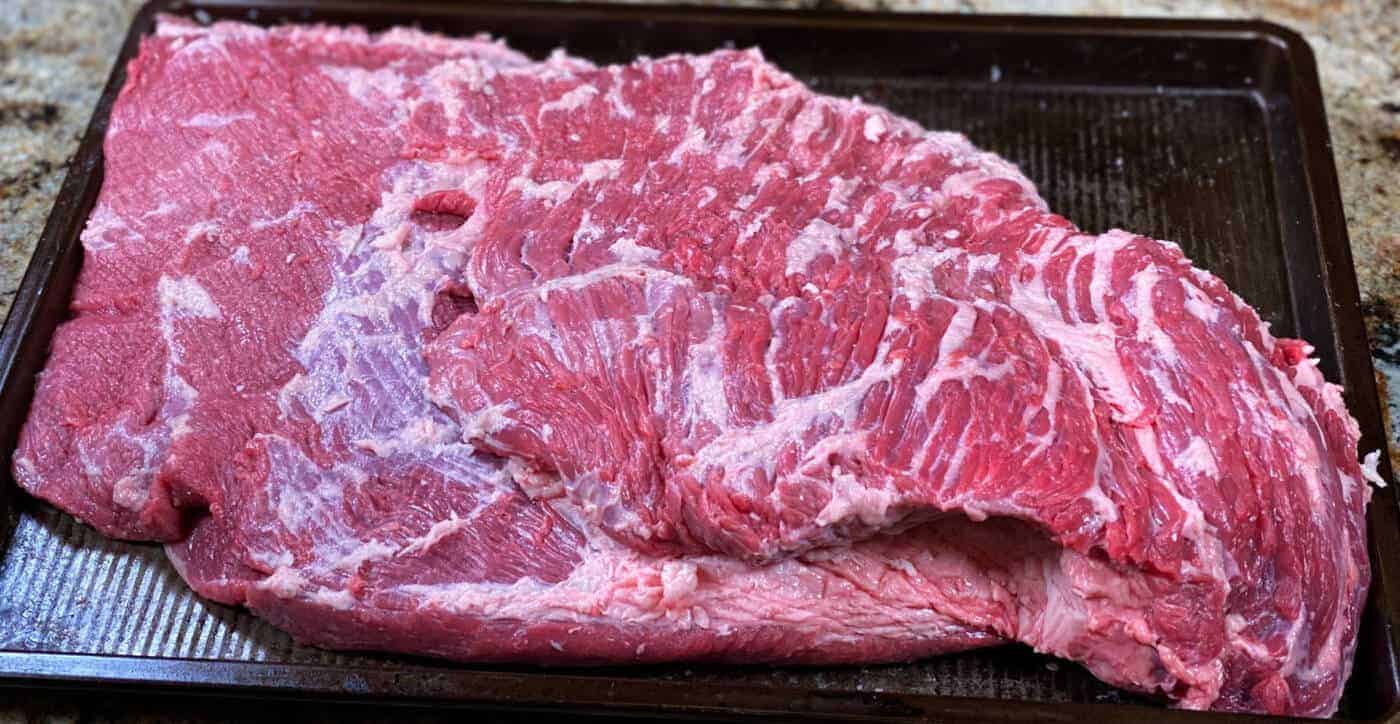
Smoking-Meat.com is supported by its readers. We may earn an affiliate commission at no extra cost to you if you buy through a link on this page.
Read this article without ads
If you've ever wanted to make your own pastrami at home for St. Patrick's Day or just because you like the stuff, then the time is now. This tutorial is part 1 of 2, and I will walk you through the easy steps of preparing and curing your own brisket.
In part 2 (located HERE), I'll show you how to do some final preparation and then smoke it to turn it into something absolutely juicy, tender, and mouth-watering!
- Prep Time: 30 minutes
- Cure Time: 6-10 days
- Cook Time: N/A
- Smoker Temp: N/A
- Meat Finish Temp: N/A
- Recommended Wood: N/A
- Packer brisket or brisket flat (trimmed is ok)
- Curing brine (below)
- Pickling spice
- Large brining container with lid (food-safe plastic or stainless steel)
To Make 1 Gallon of Curing Brine
- 1 gallon cold water
- 1 heaping tablespoon (equivalent to 1 ounce) of curing salt #1
- ¾ cup Morton's coarse kosher salt
- ½ cup dark brown sugar
I purchased a 16 lb prime grade packer brisket from my favorite local warehouse store and decided to remove most of the outer fat since it had so much fat marbling in the meat.
Here's the one I got, fat cap side down:
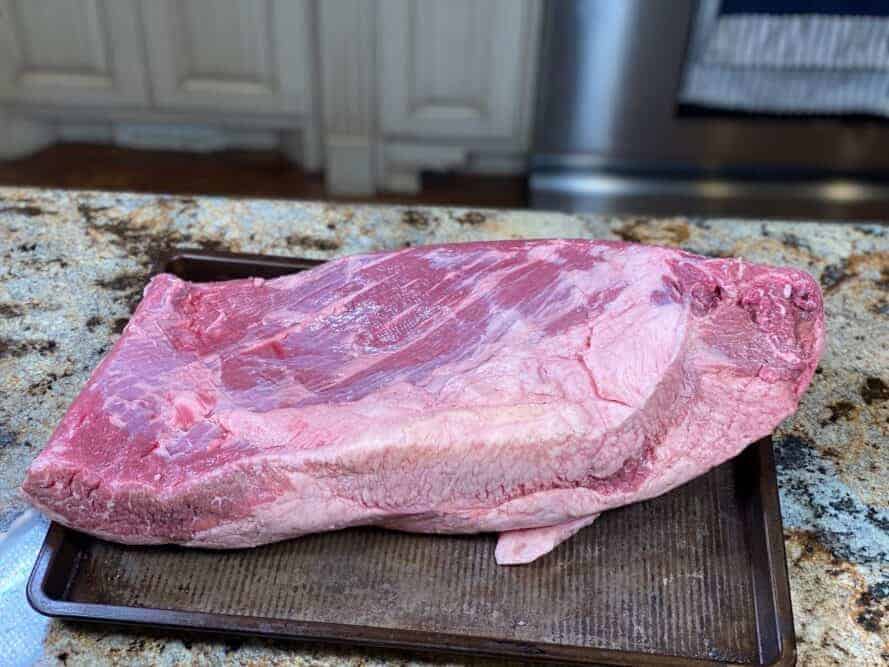
As you can see, removed the big pocket of fat on the side of the brisket first:
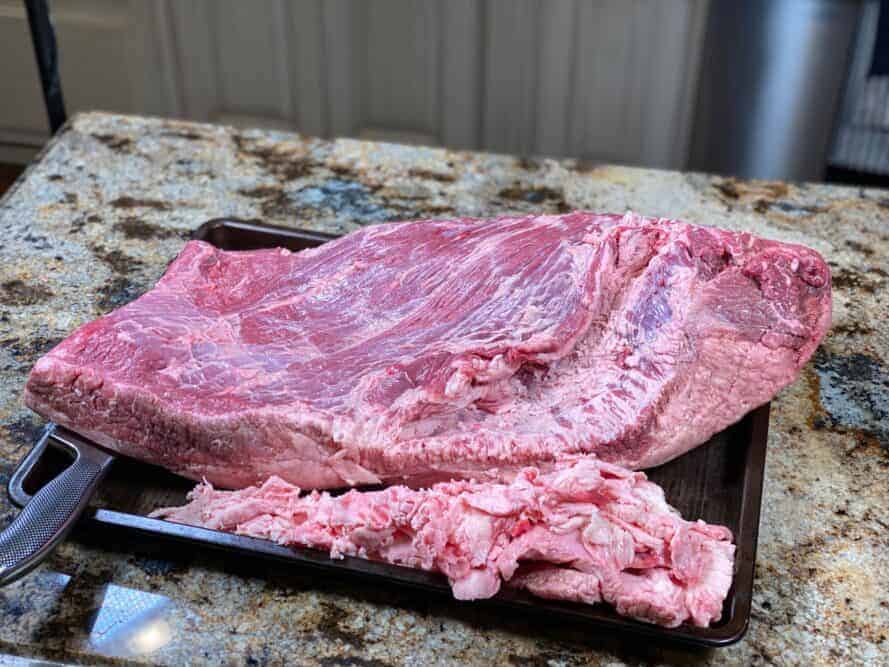
I then flipped it over to fat cap side up.
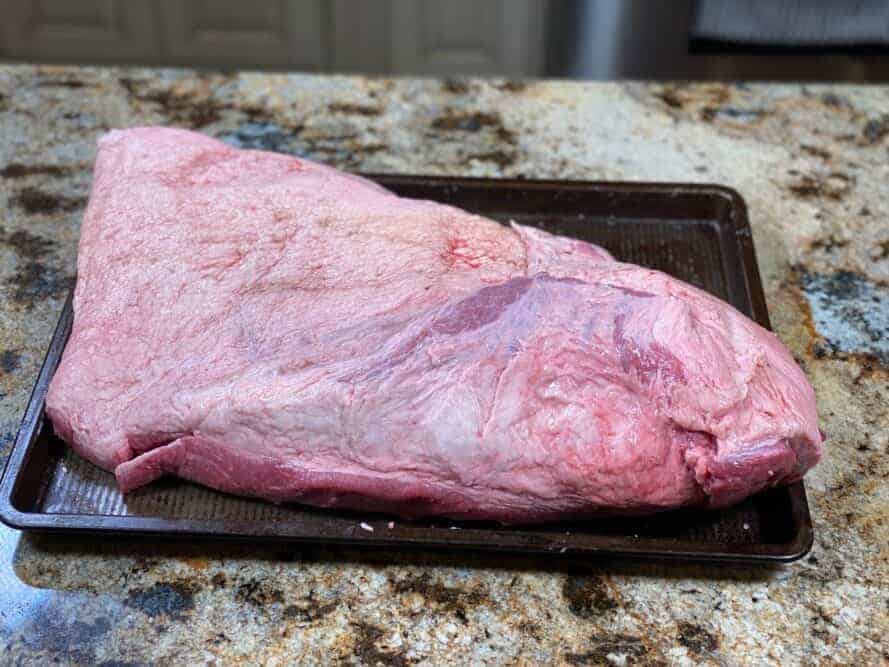
Because my aim is to cure this brisket and then smoke it, I removed most of the outer fat so the cure could have direct contact with the meat.
I went a little crazy with it but as you can see, plenty of intramuscular fat to keep it moist while it smokes.
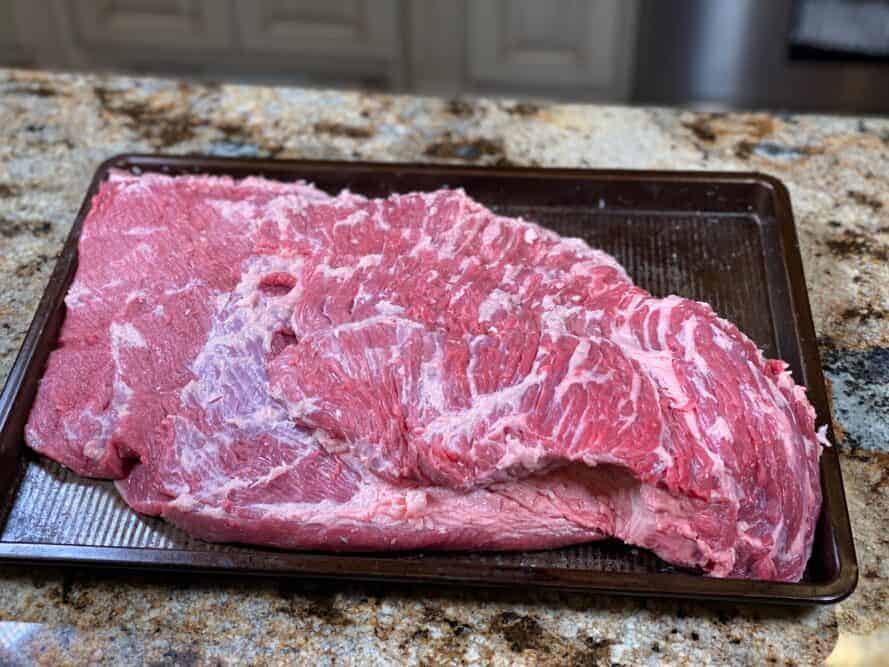
You do not have to be as brutal as I was about it and if it's a choice brisket or has less fat marbling, it's probably a good idea to leave at least some of the fat on the flat (left side of image above) of the brisket. The point (right side of image above) of a brisket is pretty fatty and can stand to have most of the outer fat removed regardless of the grade.
This thing is ready for curing!
This recipe is a slight modification of “Pop's Brine”, a recipe that has been used for a very long time by Pops, a long-time member at our forum (SmokingMeatForums.com) passed down from his father who owned a grocery/meat store for many decades.
Note: Pops has now passed away but his recipe and legacy lives on and. is used by many.
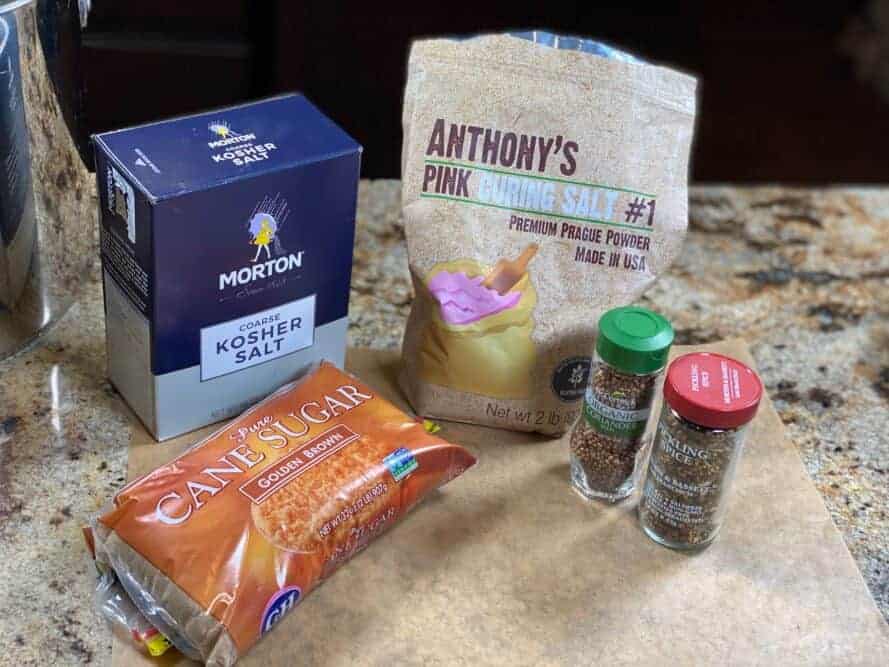
This curing brine is not based on the weight of the meat and requires no heating to make.
It is extremely easy and anyone that uses it, rarely uses anything else. I have used it for bacon and a number of other things including this homemade pastrami with the addition of pickling spices.
The maximum allowed concentration of curing salt is 3.84 ounces per gallon of water and Pop's brine uses 1 ounce (equivalent to a heaping tablespoon) per gallon. Not only does it work marvelously well, it is only 26% of the maximum allowed ratio so it's very safe.
If you can't find curing salt #1 locally, you can grab some on Amazon.
This is the kind I use:
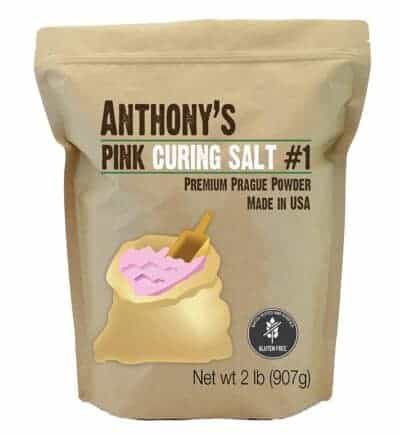
I ended up needing 3 gallons of curing brine for my 16 pound brisket so I had to triple the recipe.
Make Pop's brine by adding a gallon of cold water to a pitcher or other non-reactive container. I used a large stainless steel pot since I was multiplying the recipe.
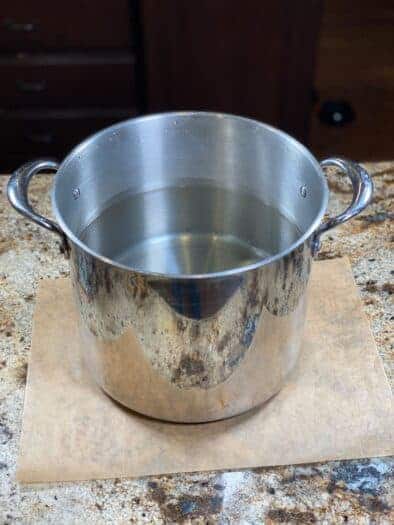
First add the curing salt #1 and the coarse kosher salt. When you first add these, the water will be very cloudy
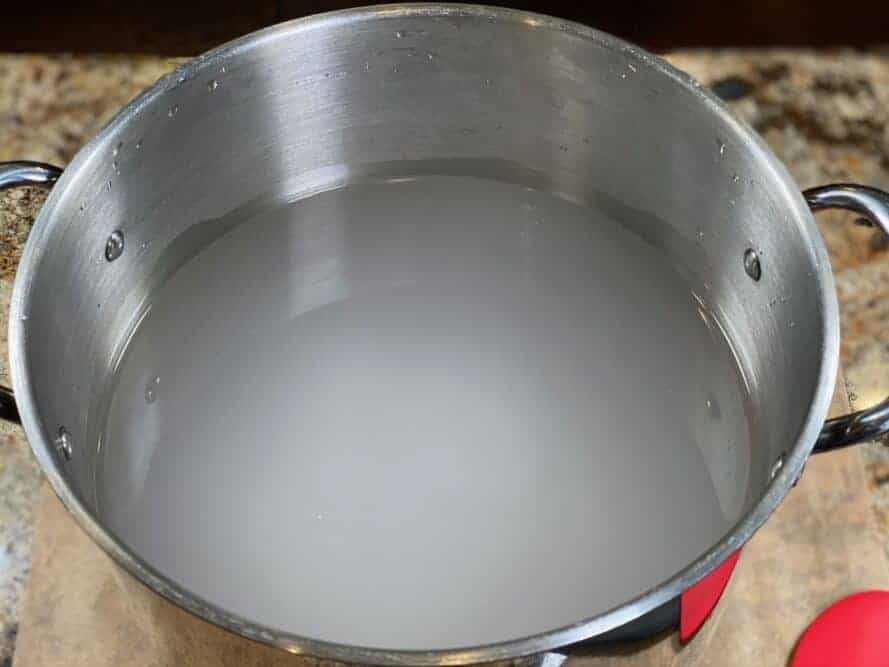
Stir for about 2 minutes or until it returns to clear again. This is a way of knowing when the salt has been completely dissolved.
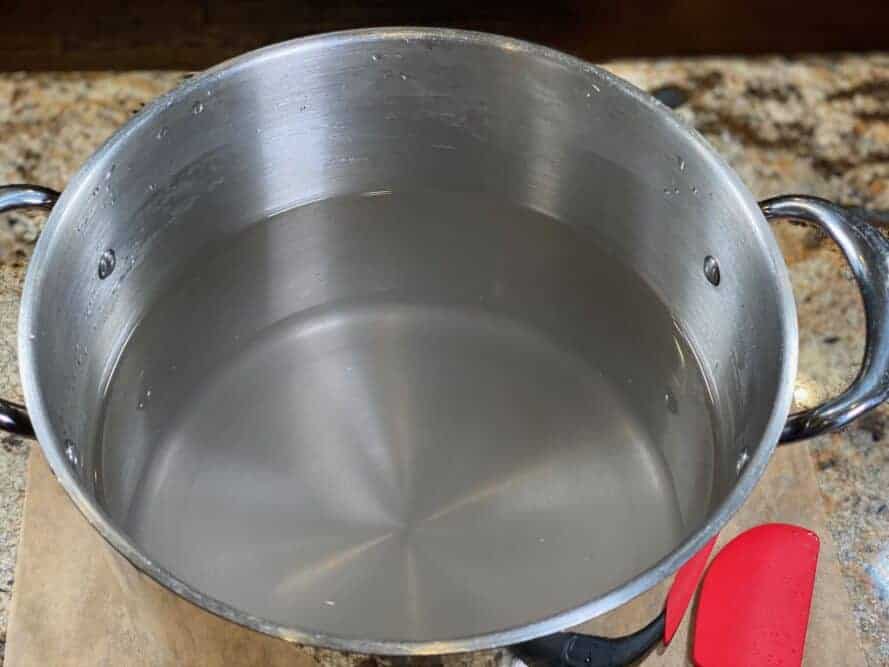
After the water is clear again, add the brown sugar and stir until it's dissolved.
Note: If you are trying to watch your sugar, you can omit the sugar. I think it adds a layer of flavor but it's still very good without it.
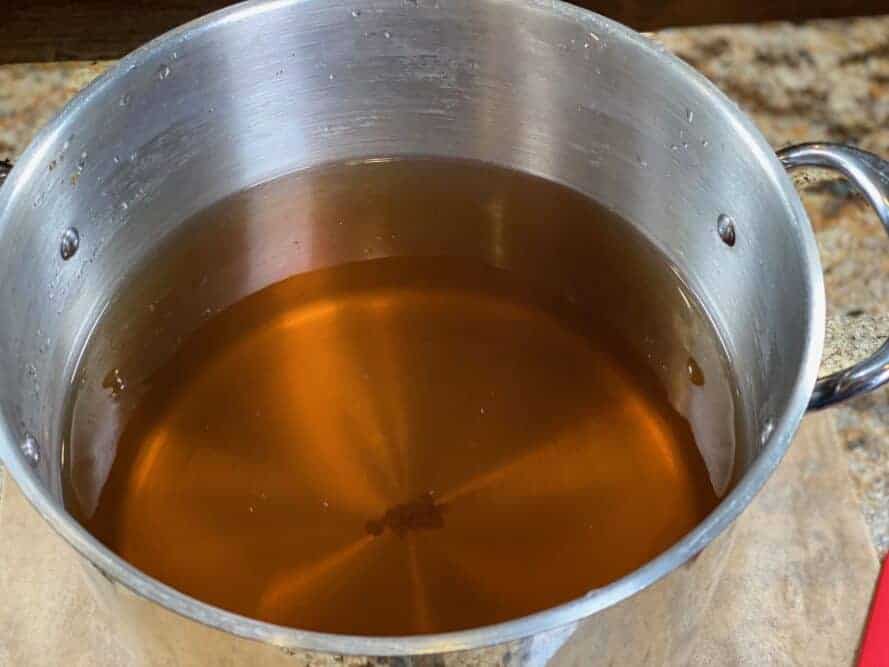
The curing part of this brine is complete but since it's going to be pastrami, we need to add the traditional pickling spices to give it the correct flavor profile. I purchase pickling spice already made up but you can make your own if you have your own recipe.
I recommend about 2 tablespoons of pickling spice per gallon of water AND I recommend toasting it before adding it to the water. This is not something you have to do but I feel like it helps to bring out the flavors a little better.
Place a iron skillet on the stove and heat it on high. Pour your pickling spices in the pan and keep the spices moving around for about a minute or until you start smelling the aroma.
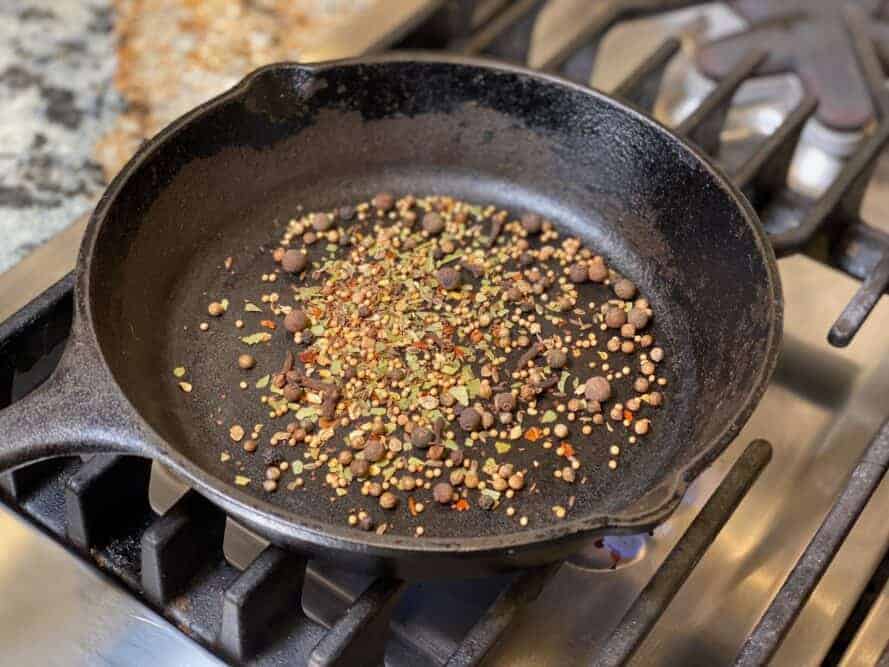
Quickly transfer the toasted spices into the water and give it a stir.
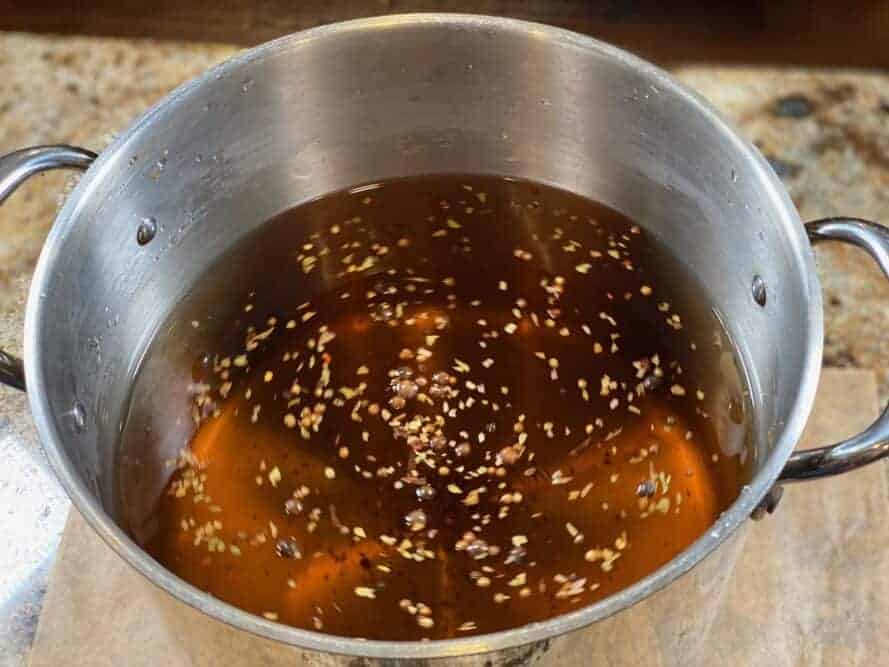
Place the brisket down in a large food-safe plastic, glass or non-reactive container and pour the curing brine over the top to cover.
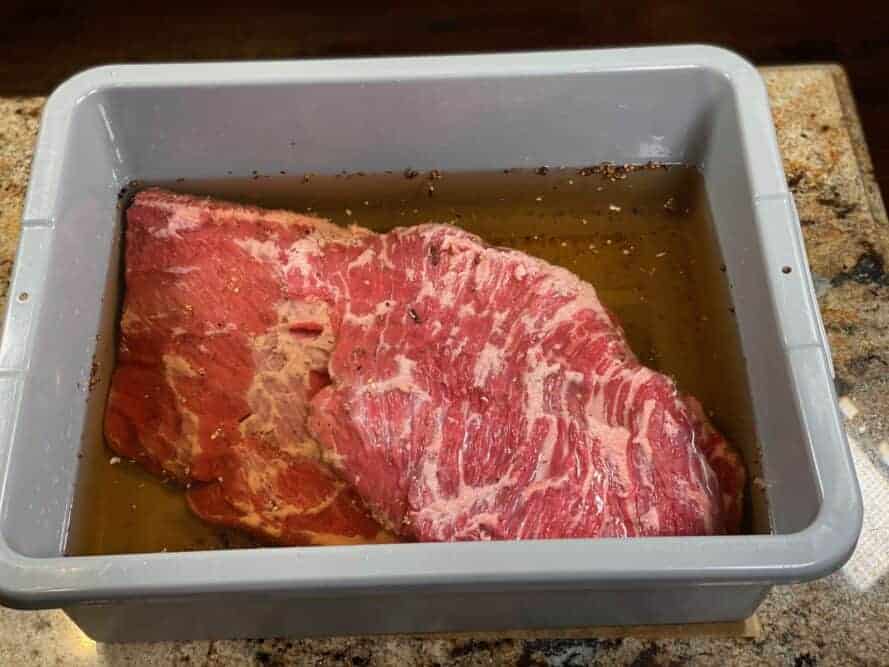
As I mentioned, I ended up needing 3 gallons to cover this big hunk of meat and because my pan was pretty large. I made 2 gallons initially and then went back and made another gallon real quick when I saw that I needed it.
Once covered, the brisket tried to float so I placed a heavy plate on top and then a zip top bag filled with water on top of that to keep the meat submerged.
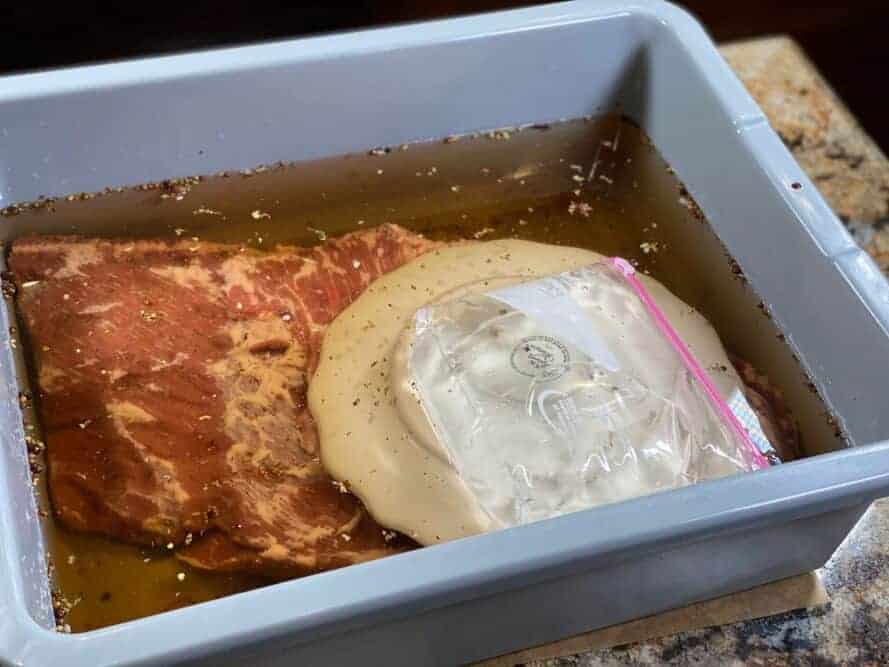
I did not have a lid for this pan so I covered the best I could with foil.
I recommend writing the planned finish date on the foil with a sharpie.
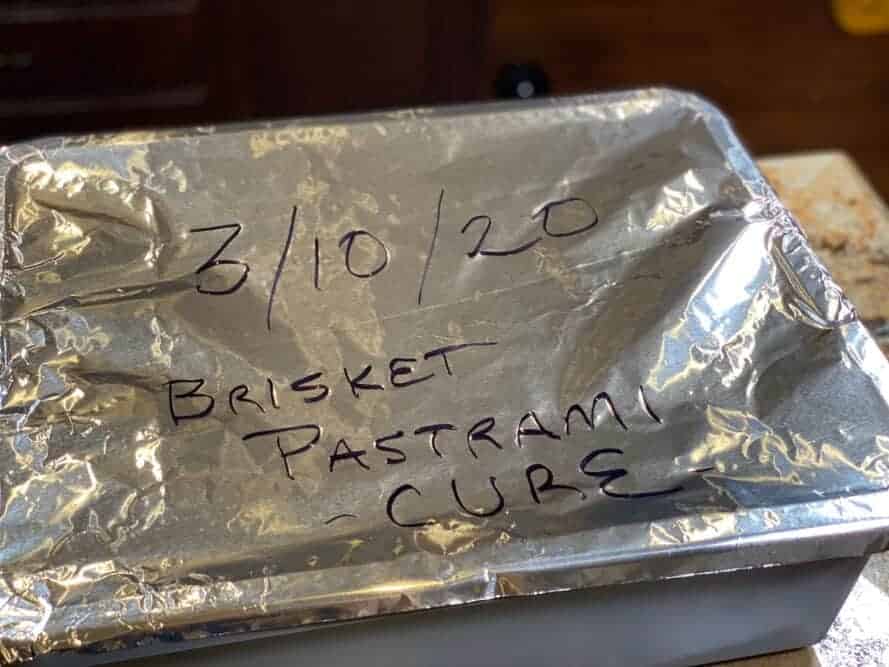
I don't do these often but a large dedicated brining pan with a fitted lid would sure be nice.
Place the container in the fridge.
I recommend curing at least 6 days but you can go as much as 10-12 days if you want or need to. Because St. Patricks day is just 12 days away, how long you cure will be determined by how quickly you can get what you need and what day you plan to cook it once it's finished curing.
Every day during the curing process, go out to the fridge, remove the cover and flip the brisket over to make sure the cure is able to move through the meat evenly.
Don't stress if you miss a day somewhere but try to do it everyday and it will reward you.
See part 2 where we smoke this thing up– HERE
Homemade Pastrami from Brisket – The Cure
Ingredients
- 1 Packer brisket (A flat or trimmed version is fine)
- 2 TBS Pickling spice (store-bought)
Curing Brine
- 1 gallon Water cold
- 1 tablespoon Curing salt #1 (heaping)
- ¾ cup Coarse kosher salt (Morton's)
- ½ cup Brown sugar (dark recommended)
Instructions
Trim the Brisket
- Trim all of the fat from the larger point end and to at least 1/4 inch or less on the flat end. If the brisket has plenty of fat marbling, you can remove all of the fat.
Make the Curing Brine
- Add the curing salt and the coarse kosher salt to the water and stir until it becomes clear (about 2 minutes)
- Add the brown sugar and stir until dissolved.
Toast the Pickling Spices
- Heat an iron skillet over high heat and place pickling spices in the pan to toast. Keep the spices moving for about a minute or until you smell their aroma.
- Transfer toasted pickling spices to the curing brine and stir.
Begin the Cure
- Place the meat into a large food-safe plastic, glass or non-reactive container. Pour brine over the meat to cover.
- If necessary, weigh the meat down with a plate and/or a zip top bag filled with water to keep the meat submerged.
- Cover the container and place in the fridge.
The Wait
- Keep the meat in the fridge for 6-10 days flipping the brisket every day for more even brining/curing.



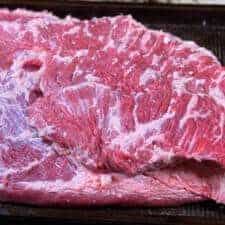
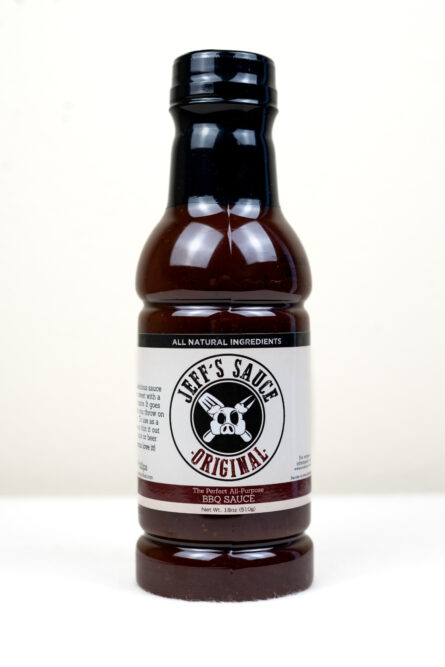
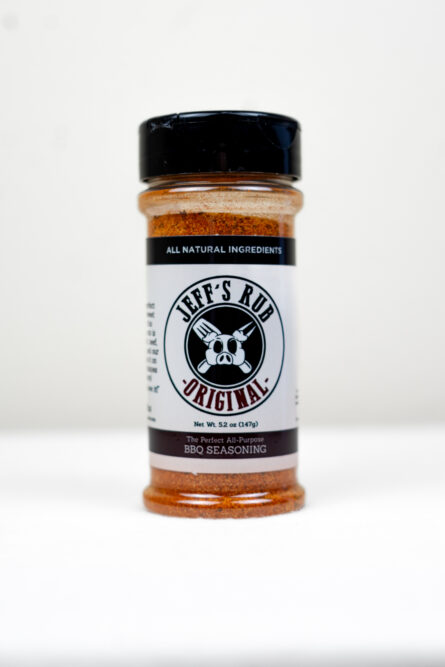
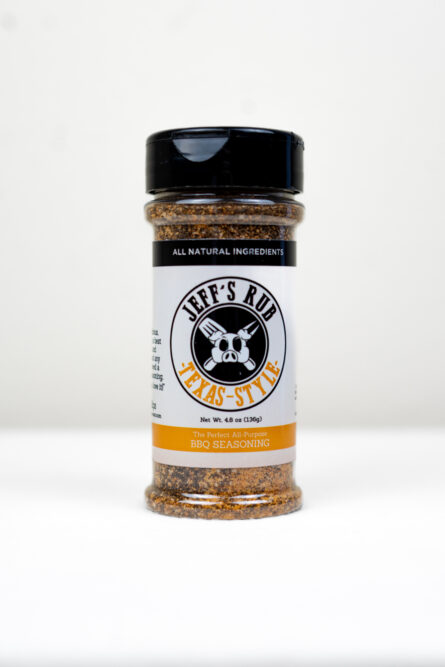
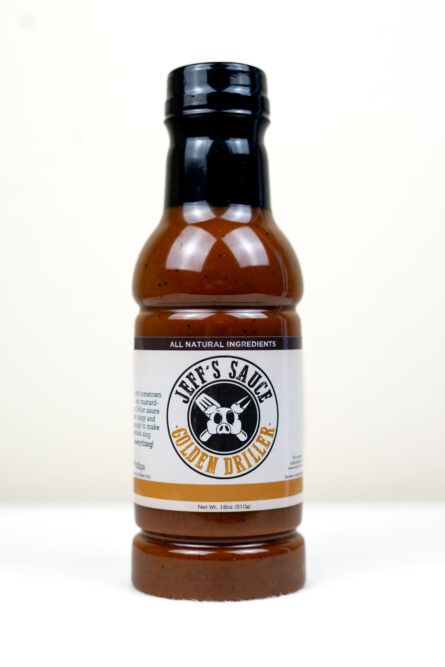
Yes, someone else who makes their own! I prefer pickling spice and garlic in my recipe. Otherwise, I also use homegrown beef so not a lot of briskets on one cow. I use shoulder (or chuck). any nicely marbled cut will work…afterall, it’s all about the flavor, right?
As I understand the process, this is actually turning the brisket into corned beef, then the smoking turns it into pastrami. The corned beef itself is a fantastic meal especially when cooked with more spices and then cabbage, onions, celery and carrots. Now that’s a St. Patricks’ day party
I cheat. I buy a corned beef in the packet and let it sit in cold water for a few hours to leach out the salt, changing the water twice, then trim, rub and onto the smoker. I also bought a small slicer on Amazon for around $80 and once it is cool, I slice it, trim out more fat and when I use it I either steam the pastrami or pan fry it.
I needed to cut a whole brisket in 2 to fit the containers that I had available. In order to vacuum seal I had to cut it again to fit the bags. It had been curing for 10 days. Is it normal for it to still be bright red (raw looking) in the center?
Your recipes are truly brilliant.
Your recipes are truly brilliant.
I have not tried curing a chuck roast, but technically it should work just the same as a brisket.
Jeff,
I switched to using chuck roasts several years ago when brisket prices skyrocketed. I find they work great for both corned beef and pastrami….
I have used several commercial pickling spice blends as well as have made several tries at blending my own…… I have found that McCormicks brand provides a flavor profile I prefer…..
Also, when doing pastrami I am still experimenting, but I start the cook process with several hours in the smoker and then transfer the meat to a vac seal bag to finish cooking in the Sous Vide….. I finish the pastrami in high heat in the oven to re-set the bark
This is ready to eat after 6 to 12 days without baking or smoking it
After the curing process, it will need to be cooked in the smoker. I will be sending out instructions for that in the next few days.😀
What is the difference between corned beef and Pastrami ? I’ve always been a corned beef guy. I like pastrami too. Does the recipe change at some point for one or the other?
Pastrami is just corned beef that’s been smoked. Once you smoke it, it becomes pastrami.
Good morning,
Can this cure recipe be used on pork to make ham? Or do you have cure recipe you like to use to make ham? Thanks!
Kari, Yes, absolutely! This cure will work on ham, corned beef, bacon almost anything you want to wet cure. When you are curing a really thick piece of meat like a pork shoulder to make ham, you will also need to inject the cure into the center of the meat to make sure it is curing from the inside out as well as the outside toward the center.
I need to write up instructions for curing ham as well.. maybe before Easter🐣😃
Thanks for clear instructions .
I have done this a few times. Easy to make your own pickling spices. Chef John has a recipe I used for pastrami. I usually sous vide my brisket because I tire of long hours tending the smoker. After sous vide I find that 2-3 hours of smoke is just fine. This year, as an experiment, and because brisket is so costly, I found some beef chuck roasts on sale (3.50 lb.) and I am currently brining them for St. Paddys. One we just plan to heat up in the oven when pickling (12 days) is finished. The other I am going to try making into pastrami again. I will try to let you know how it comes out.
I’ve made this pastrami a few times and I really like it. I do have a question. If I use my chamber vacuum sealer and seal the brisket while it’s curing, will that cut down the curing time? And if so by how much?
i have same question, have you had any luck or tried it? all vac sealer will really do is just remove all air.
How long do you smoke it and at what temp,
when is it done ???
It can take 12-18 hours depending on the size of the brisket. I usually cook mine in a range of 225°F (107°C) to 240°F (116°C) most of the time. You can see more details at Homemade Pastrami from Brisket – The Smoke
How long do you smoke it for?
Is Mortans tender quick just like kosher salt?
Totally different product. Kosher salt is just salt that is flaked and tends to dissolve easily in water. Tender Quick is a mix of salt and chemicals that work together to cure meat.
hello Jeff,, long long time follower, 0 posts, but after I tried this awesome recipe I wanted to thank you for the website and ask you a simple question. I had been looking elsewhere near me to buy the pink salt. no one sold it so I ordered Morton TQ on the net.. because of the size I also had to make a triple of the recipe on the bag(1 cup/ 1gal) it turned out SO SALTY it could not be eaten.
I did soak it for 6 hours and changed the cold water every hour. I then rinsed it really well before putting your rub on it. will you please tell me if you have a recipe for cure that doesn’t have so much salt?
I am sure you have so many people asking you for help constantly. if and when you have time I would very much appreciate your input….
If it’s Broke,, it Probably Needs Fixin’
I only use Curing salt #1.. Mortons TQ is a completely different product and has very different ingredients. I recommend ordering the stuff I use on amazon at https://www.smoking-meat.com/curing-salt-1 and you will get much better results.
Pastrami is cured with a dry rub. Not a brine like corned beef.
Dick, sort of like making bacon, you can dry rub or wet rub as long as the ratio of pink salt is correct. it’s still bacon regardless if which method you use and likewise pastrami. Is this the way that is most used around the world.. I have no idea but it is a legitimate corning method.Pastrami is more about the smoke than the cure.
Pastrami is smoked peppered corned beef, no matter whether it was wet or dry cured.
Jeff,
Why is the curing salt needed?
The curing salt along with the pickling spice is to give it that unique flavor.
How many people will this serve? I’ve got a 13lb in the brine now. Will have plenty of sides.
I usually purchase 1 lb per person + 2 lbs. It will cook down about 40-50% during the cooking process which gives you ½ lb per person and a little extra.
With that in mind, the 13 lb brisket will feed about 11 people.
Can you skip part one and just buy a corned beef and proceed to step 2 ??
Yes.. you can do that.
Do you need to desalinate in pure water when done curing?
Jay, I recommend rinsing the meat once it’s finished curing and then test a small piece in a frying pan. If it’s too salty, you can then soak it for a few hours in fresh water to remove some of the salt but this is rarely needed if you follow my recipe for curing. I use less salt than most in my curing brine and it works great and does not create an overly salty piece of cured meat.
I’ve been making pastrami’s from corned beef for years. Soak it overnight in tap water, changing the water twice and you’re good to go
Jeff, In one of the pictures I saw a container of Coriander, but I didn’t see it in the recipe. Is it part of the pickling spice? How much is needed?
Sorry about that.. the coriander was already in the pickling spice so I decided to not use it any extra in the curing process. I used the coriander in the rub that I put on the brisket after it was cured.
I avoid the brining part altogether and buy a corned beef brisket. Wipe of the slime and soak it for a few hours changing the water once or twice to remove the salt and use a rub made up without the salt. Works like a charm. Plus, corned beef goes way down in price in the days before St Patrick’s Day and I have plenty of room in my freezer.